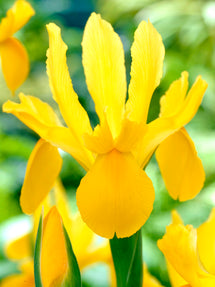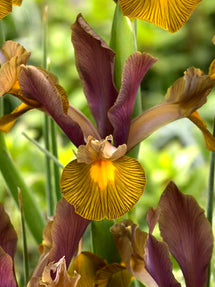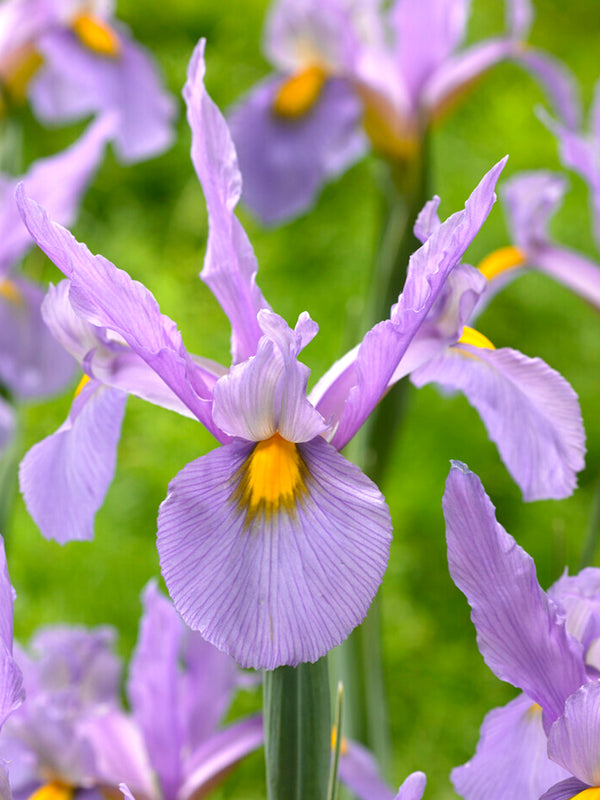Iris
Enliven The Spring Garden With Colorful Iris Flowers
Add striking color and grace to your garden with beautiful Iris flowers. These elegant blooms are available in many shapes and in almost every color. Colors include the familiar blue, violet, purple, yellow, and white, as well as lesser-known shades such as bronze, orange, and even pink. These stunning plants add structure, texture, and charm to your outdoor space. They’re easy to grow, dependable, and beloved by gardeners of all experience levels.
At DutchGrown, you’ll find a carefully curated selection of Dutch Iris and Dwarf Iris bulbs, perfect for creating a garden that’s both beautiful and uniquely yours. Start planning your majestic garden in the US today.
Showing 1 - 2 in 2 items
Top-quality dutch and dwarf iris bulbs for sale
From Bearded Iris to Siberian Iris: Popular Flowers Throughout The Centuries
The genus Iris belongs to the Iridaceae family and includes hundreds of different types, including Dutch Iris, Japanese Iris, Dwarf Iris, Bearded Iris, and Siberian Iris. The name “Iris” originates from the Greek word for "rainbow". It is one of the earliest cultivated garden plants, dating back over 2,000 years. With an extraordinary history, these elegant flowers have graced the gardens of Pharaohs, medieval monasteries, and royal estates alike. Their enduring popularity lies in their striking elegance, characterized by upright blooms and sword-like foliage, which works beautifully in formal beds, cottage gardens, and naturalized settings. Their vibrant hues also make them a top choice for cutting gardens and floral arrangements.
Despite their elegant appearance, Iris flower bulbs are surprisingly easy to grow. They thrive in most well-drained garden soils and adapt well to a variety of climates. Even beginner gardeners can enjoy success with Irises, as these low-maintenance bulbs return each year with minimal intervention. Many varieties will multiply naturally over time, expanding their presence season after season. To create a full and colorful spring display, combine Iris bulbs with other plants, such as Tulips, Daffodils, and Hyacinths.
Dutch Iris vs. Dwarf Iris Bulbs: Two Species Worth Growing
At DutchGrown, you'll find a carefully curated selection of various Iris species available. Two species we would like to highlight are the Dutch Iris and the Dwarf Iris. Both offer exceptional beauty and performance, yet each brings something different to the garden.
Dutch Iris (Iris Hollandica): The Late Spring Bloomer
The Dutch Iris (Iris “Hollandica”) is known for its tall stems and orchid-like flowers with silky petals. Blooming during late spring, they are perfect for extending the season into early summer. Dutch Irises bloom in a stunning array of colors, some with exotic markings. The flowers are well known for their long vase life, as they hold up well in floral arrangements. Fun fact: Dutch Iris flowers have never grown wild in the Netherlands, but they are a result of clever hybridization by Dutch growers.
Dwarf Iris (Iris Reticulata): The Small, Early Spring Bloomer
The Dwarf Iris (Iris “Reticulata” or “Reticulated Iris”) is an early spring bloomer that often flowers while traces of late winter are still present. Its petals are typically blue and purple, though some varieties have white flowers. This compact and low-growing plant is ideal for planting in front borders, under deciduous trees, in rock gardens or pots. It creates lush displays in early-season landscapes. Their ability to thrive in small spaces makes them a favorite among gardeners with limited room or in cooler spring climates. Fun fact: “Danfordiae” is the only yellow Dwarf Iris variety.
How To Grow Iris Plants For Maximum Effect In Your Outdoor Space
Their orchid-like blooms may look exotic, but Iris bulbs are surprisingly easy to grow. To achieve the best growth in your spring garden, proper planting is essential. Here’s how to do it:
Plant your Iris bulbs between early and late fall, when the soil temperature drops to 60°F or lower. This typically occurs between September and November, depending on your local climate. Choose a location with full sun to partial shade and well-drained soil, as Iris bulbs do not thrive in wet conditions. Next, space the bulbs about 3 inches apart and plant them 4–5 inches deep, with the pointy end facing up. If you're planting in containers, you can place the bulbs a bit closer together, but ensure they never touch each other. After planting, only water thoroughly once and moderately during the growing season to prevent standing water. Do you live in USDA zones 3 through 7? Move the containers to a protected space, such as an unheated garage or basement, to overwinter. Read more in our article about how to store Iris bulbs.
After flowering, allow the foliage to die back naturally. Wait until the leaves are completely yellow and withered before removing them. Do you need specific help? Follow the instructions in our growing guide “How to Grow Iris?”.
Dwarf Iris And Dutch Iris Bulbs For Sale At DutchGrown
Would you like to grow Dwarf and/or Dutch Iris in your garden? Whether you're planting a few bulbs in your home garden or designing a larger landscape, they both deliver exceptional performance. At DutchGrown, you'll find only top-quality Dwarf and Dutch Iris bulbs (bulb size between 2 and 3 inches), carefully selected for their strength and reliable blooms. Our curated collection includes classic favorites and unique varieties, making it easy to find the right variety for your space. Buy Iris bulbs online and start planning your spring garden to be rewarded with a burst of color. We ship throughout the US.
Frequently Asked Questions About Iris Bulbs
What Is An Iris Bulb?
An Iris bulb is an underground storage that produces the elegant, colorful Iris flower. The bulb contains all the energy the plant needs to sprout, bloom, and return year after year. While some varieties grow from Iris rhizomes, others grow from bulbs. There are various species of Iris, including Dutch Iris, Japanese Iris, Dwarf Iris, Bearded Iris, and Siberian Iris.
What Time Of Year To Plant Iris Bulbs?
Iris are spring-flowering bulbs that should be planted in the fall. The exact timing depends on your climate. In cooler regions, plant them in September or October when soil temperatures drop to around 60°F. In warmer areas, October to November is the ideal time. You can find more information in our article “When to Plant Iris Bulbs?”.
Do Iris Bulbs Need To Be Dug Up Every Year?
Iris bulbs don’t need to be dug up every year. They’re perennials that often multiply when planted in the right conditions. They are cold-hardy in USDA zones 5–9. If your Irises stop producing blooms, they may have become overcrowded. Dig up the bulbs in early fall and separate them before replanting. Learn more in our article about how to replant Irises.
Will Iris Bulbs Multiply?
Iris bulbs will multiply in the right circumstances. Over time, they form Iris clumps that grow larger each season. To keep them healthy and ensure they continue to bloom well, it’s best to divide and replant them every 3 to 5 years. This prevents overcrowding and ensures that each bulb continues to produce strong, showy flowers year after year. Read more in our article “How to Divide Irises?”.


